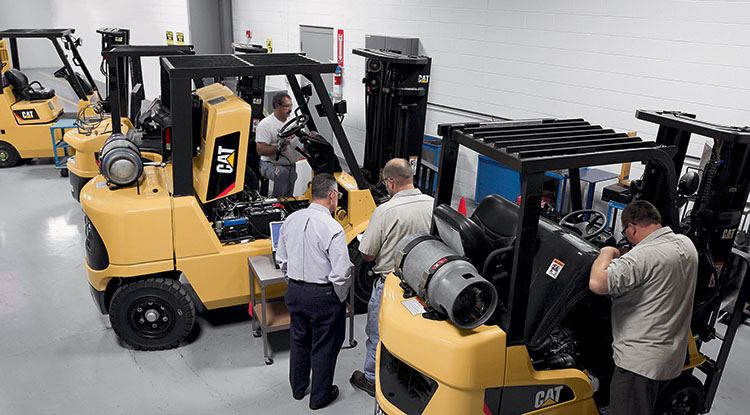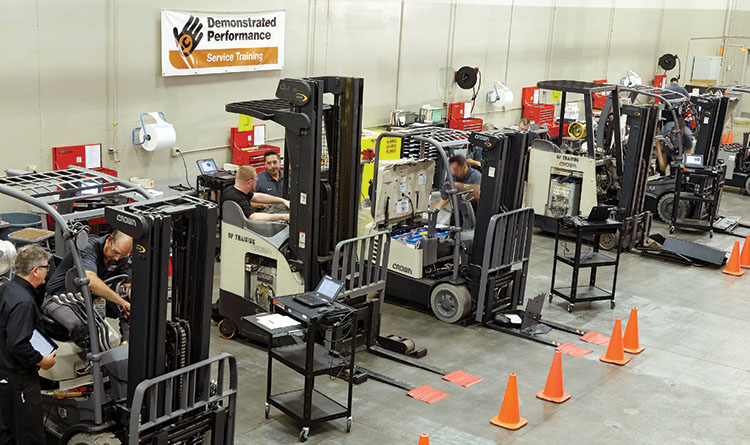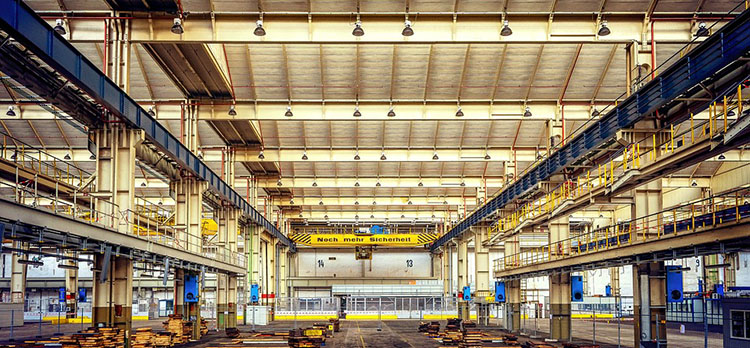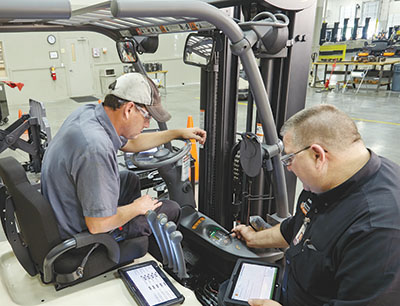Lift Trucks: A new technician vision
The demographics of technician hiring and retiring do not paint a pretty picture for the near- or long-term future of the technical workforce. The lift truck industry is attacking the shortage head-on with improvements and initiatives designed to grow the technicians of tomorrow—today
The modern business climate demands equipment uptime, so it’s not surprising to see similarities in the conversation around lift truck maintenance and the high-stakes airline industry.
To meet increasingly strict standards of lift truck fleet performance, a stable of skilled technicians equipped with modern tools is essential. However, between a lack of incoming talent and the ongoing retirement of Baby Boomers, the numbers don’t add up to a sufficient pool of workers.
Whether aviation, automotive or agricultural, the talent shortage is a growing concern in all skilled trades, but is especially pronounced in materials handling, which is somewhat less visible to young people than a profession like an electrician or plumber.
After decades of cultural emphasis on a four-year degree, technical schools are also struggling to attract young people. As Mike Rowe of “Dirty Jobs” fame said in his ProMat 2015 keynote, “we became so preoccupied with getting into the corner office that we forgot how to build one.”
Having felt the strain of attracting technicians—and in anticipation of the problem only worsening—lift truck manufacturers and dealers have mounted an aggressive campaign to rethink their approaches to recruitment, retention and training.
The pursuit of new recruits
It’s no longer good enough for a modern technician to be handy with a wrench; they are also the customer-facing ambassadors of the dealer and equipment manufacturer.
“They touch more of our customers than any other part of our organization,” says Neal Hittepole, director of aftermarket development for Crown Equipment. “Customers expect more from a technician, and our whole success relies on how well we do with recruiting, hiring and training.”

The question each employer must then face is whether it’s best to hire someone with the hard technical skills and train the soft customer service skills or vice versa. The ideal mix is a bit of both, which is challenging a hard-skill-centric talent pipeline to adapt. As a result, prospective employee outreach is evolving rapidly, says Jim Bladel, manager of technology training delivery and development for Hyster Co.
“Dealers are coming to the realization that they have hired all the experienced technicians they can get, and that we now need to start growing our own,” Bladel says. “It might not be a glamorous industry, but I don’t know if young people realize how stable it is. Since 1978, I’ve been laid off a total of four months.”
To effectively make their case, dealer representatives can’t just hand out pamphlets to students about to graduate from technical schools. According to Troy Kaiser, national manager of training and customer center operations at Toyota Material Handling U.S.A., outreach efforts might begin as early as middle school and require a concerted, company-wide effort.
“Our marketing team is now integrally involved at a corporate level in the recruitment of technicians, and we then pass leads on to dealers,” Kaiser says. “That’s a big difference from where we were even two years ago, when recruitment was the responsibility of each dealership and training department.”
There’s also a push at the corporate and dealership levels to partner with local educational institutions to develop prospective technicians and the necessary curricula to prepare them for work. Employers have to navigate a tricky path here, too, because the level of interest among those institutions varies.
“Technician recruitment is still one of the biggest issues dealerships have, and it’s quite a problem,” says Kevin Fick, director of aftermarket for UniCarriers Americas. “Some schools have zero interest in collaborating, and if they have regular diesel or automotive programs, they don’t see the value of expanding into a different category. On the other side are those who welcome partnerships with open arms and help develop a good curriculum and a supply of technicians. We’ve also seen success with placement programs that target military veterans, although dealers are often unaware of those opportunities.”
Promoting the career path
Once a worthy candidate is hired, the challenge shifts to retention, which is especially difficult in an environment with such a shortage of talent.
“The problem with failing to grow your own technicians is that they will jump ship for 50 cents more an hour,” says Rex Bendure, senior product support program manager for Mitsubishi Caterpillar Forklift America. “If you get them young and keep them loyal, they’re more likely to stick around.”
Nearly all manufacturer forklift-training programs are being updated to promote education, with an eye toward standardization, comprehensive skill development and the elimination of the possibility of career stagnation. Kaiser cites statistics that suggest 40% of new hires are lost within a year, and 75% of them cite lack of training.

“We’ve developed a comprehensive ladder of expertise with certifications for beginners and experienced technicians alike,” Bendure says. “The minute you get comfortable, you’re not growing and learning. The majority of technicians believes that, and like what they do enough to learn more. They might think they know it all, but when offered something new they will grab onto it.”
Crown’s Hittepole says training can help overcome any resistance among seasoned technicians to new technologies.
“Technology sometimes scares older technicians a little,” Hittepole says. “Three years ago, we rolled out our mobile service platform pretty aggressively, going from paper to primarily tablet-based in about four to five months. As you can imagine, we had a handful of technicians who needed extra time to adapt to it. After training to help them understand what was there, it became very intuitive and quickly got comfortable.”
Smart technologies help distribute information, but many training programs still rely on in-person meetings. However, a regular schedule of travel for central training and education can be costly and time-consuming for many dealerships. Training programs have evolved by offering programs that can be implemented locally to ensure access to educational resources.
“We’re working with our training group to provide some core concepts and even some guidelines for how to develop relationships with other agencies or institutions,” says Jim Hauss, manager of field service for The Raymond Corp. “However, this standardization doesn’t preclude their local personality because it is very important for dealers to maintain their identity.”
The personal touch goes a long way toward satisfying both customers and technicians. A 40-year industry veteran, Bladel says the best way to retain an employee is to provide and constantly reinforce a vision of the career path ahead.
“When I started in this industry I though I’d just do this until something better came along. Nothing has,” Bladel says. “When I got that first job, the dealer manager told me how I would complete training, how it would have an impact on my compensation, and outlined my path.”
That said, compensation is not everything. “When Millennials only stay at a job for two years, it’s because it looks like the grass is greener somewhere else. If you show them where they are today and where they’ll be in six months, a year, five to 10 years, they’ll see that path. As an industry, my opinion is we don’t do a good enough job of that.”
At UniCarriers, Fick says labor management systems (LMS) have helped track each technician’s progress along their path. Previously, aside from manually parsing class lists, there was no centralized way to see who had taken which course and when.
“If you have a few journeymen who are one or two classes away from master, you can make it happen,” Fick says. “The online LMS library also included several courses in soft skills so that, in addition to product information, dealers have access to primers on phone skills, customer service, day-to-day operations, how to ask questions, get relevant information and close a conversation. They can use these resources in lieu of a class from an outside consultant.”
Bridging the gap
Standard training programs ensure all technicians are familiar with the technology in the equipment as well as the technology they use to service it.
“What was considered exceptional service two years ago is now expected as an ante to get into the game,” Hauss says. “Back when lift trucks were simple, someone who was a good wrench-turner was more than good enough. Now, in addition to mechanical skills, a technician now needs to deal with networks and servers and databases, things outside the previously expected strengths. We average 10,000 customer interfaces a day at the technician level, and every one is an opportunity to continue with a customer, win a new one or lose one; and we have to be equally good at all of those.”
When the toolbox includes smart phones and tablets, Fick says a technician can communicate with his supervisor, send live video to help troubleshoot, order parts, access reference materials, or take pictures of a work order once it’s signed off to speed up the invoicing process.
“Connected” technicians are serving customers who are also increasingly sophisticated and technology-savvy, with technologies that offer visibility into work orders, parts inventory and more in real time. As customer business systems have changed, there is an opportunity for service providers to be more involved in broader conversations.
“It’s important that technicians really understand warehouse operations and what logistics professionals need to do to be successful,” says Kaiser, citing the value of a comprehensive curriculum Toyota developed in partnership with Vincennes University.

“In that program they talk about not only fixing the forklift, but its value from an operational standpoint,” Kaiser adds. “If the technician understands batch versus discrete versus wave or zone, they can help identify the right materials handling equipment. If there are any issues, the technician can determine whether it’s the equipment or how the application is being run. Should the customer consider, for example, a different picking strategy to optimize the uptime of equipment?”
Kaiser recommends mentorships as one of the best ways to cultivate this knowledge on an ongoing basis. The science of a customer’s equipment and application can be handed down, but it is more difficult to pass on the art of the relationship a senior technician has established.
“A couple dealers have pioneered this idea and have created mentorship and apprenticeship programs,” Kaiser adds. “You can hunt all day in a bidding war for someone with 10 to 20 years of experience or can develop that talent on your own. That’s the future we see to fill that void.”

Article Topics
Warehouse News & Resources
The Ultimate WMS Checklist: Find the Perfect Fit 40th Annual Salary Survey: Salary and satisfaction up Data Capture: Bar coding’s new companions Salary Survey: Pay, satisfaction, youth on the rise Examining the impact of the Taiwan earthquake on global supply chain operations Reverse Logistics: Best Practices for Efficient Distribution Center Returns Exploring Customized Forklift Solutions More WarehouseLatest in Logistics
LM Podcast Series: Assessing the freight transportation and logistics markets with Tom Nightingale, AFS Logistics Investor expectations continue to influence supply chain decision-making The Next Big Steps in Supply Chain Digitalization Warehouse/DC Automation & Technology: Time to gain a competitive advantage The Ultimate WMS Checklist: Find the Perfect Fit Under-21 driver pilot program a bust with fleets as FMCSA seeks changes Diesel back over $4 a gallon; Mideast tensions, other worries cited More LogisticsAbout the Author
Subscribe to Logistics Management Magazine

Find out what the world's most innovative companies are doing to improve productivity in their plants and distribution centers.
Start your FREE subscription today.
April 2023 Logistics Management

Latest Resources
















